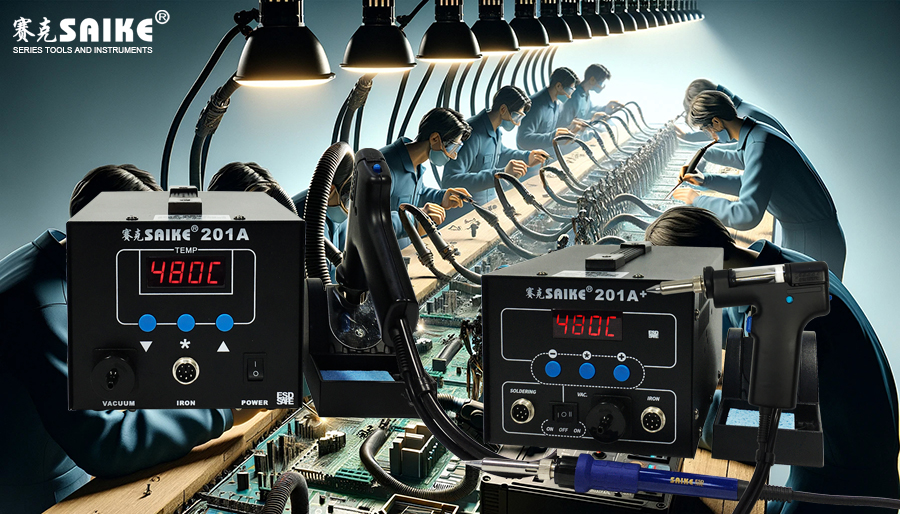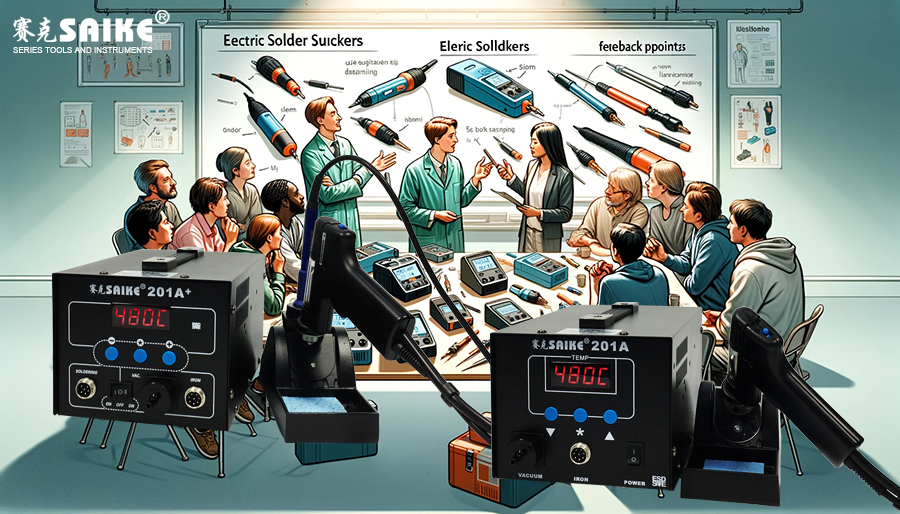
SK-YJ000DDXXQ-KP 100023
The electric solder sucker is an indispensable tool in electronic maintenance, and proficiency in its operation is crucial to improving maintenance efficiency and quality. This article will introduce the use of electric solder suckers in detail through graded exercises, from simple operations to complex applications.
I. Basic Operation Practice
1.Preparation
– Equipment check: Ensure that the electric solder sucker is not visibly damaged and the power cord is intact.
– Soldering iron tip selection: Choose an appropriate soldering iron tip based on the size of the soldering joint.
– Preheating: Preheat the solder sucker to the recommended operating temperature (usually between 350°C and 400°C).
2.Simple Solder Joint Sucking
– Objective: Practice solder sucking on a single soldering joint.
– Steps:
– Align the preheated tip of the solder sucker with the soldering joint.
– Ensure that the soldering iron tip completely covers the soldering joint to optimize heat transfer.
– Once the solder melts, immediately activate the solder sucking pump to quickly suck away the melted solder.
– Note: Avoid overheating for too long to prevent damage to the circuit board.
3.Cleaning and Maintenance
– Cleaning the soldering iron tip: Use a wet sponge or specialized cleaning ball to remove residual solder from the soldering iron tip.
– Checking the solder sucking pump: Ensure that the solder sucking pump channel is unobstructed.
II. Advanced Operation Skills
1.Continuous Solder Sucking on Multiple Soldering Joints
– Objective: Improve efficiency and accuracy in continuous operations on multiple soldering joints.
– Steps:
– Plan the operation sequence, moving in the shortest path possible.
– Quickly transition from one soldering joint to the next, reducing heating time and waiting time.
– Tip: Master the angle and position of the soldering iron tip to ensure that each solder sucking can completely remove the solder on the soldering joint.
2.Desoldering of Sensitive Components
– Objective: Safely remove sensitive components such as transistors and IC chips.
– Steps:
– Lower the temperature setting of the solder sucker to accommodate sensitive components.
– Use a fine soldering iron tip and try to shorten the solder sucking time.
– Note: Plan the heat distribution ahead of time to avoid component damage due to overheating.
III. Advanced Technical Challenges
1.Desoldering on Complex Circuit Boards
– Objective: Perform precise desoldering operations on dense and complex circuit boards.
– Steps:
– Use a high-precision solder sucker with adjustable suction.
– Integrate rapid heating and instant solder sucking techniques for precise control.
– Tip: After each operation on a complex circuit board, check if adjacent components are affected to ensure precise and safe operation.
2.Safe Removal of Aged Components
– Objective: Safely remove aged components during the maintenance of long-unmaintained electronic devices.
– Steps:
– Use a low-temperature and slow solder sucking strategy for aged solder.
– Pay attention to checking the physical state of components and circuit boards to prevent damage caused by fragility.
– Note: When handling aged components, additional support and protective measures should be used, such as thermal protection tape.
IV. Summary
Through graded exercises from basic to advanced levels, operators can gradually improve their skills and efficiency in using electric solder suckers. Basic operations familiarize beginners with the equipment, advanced skills help improve professionalism, and advanced technical challenges enable operators to maintain efficiency and precision in complex environments. Regular practice and reflection are key to skill improvement, and proper maintenance is also an important factor in ensuring equipment performance.


